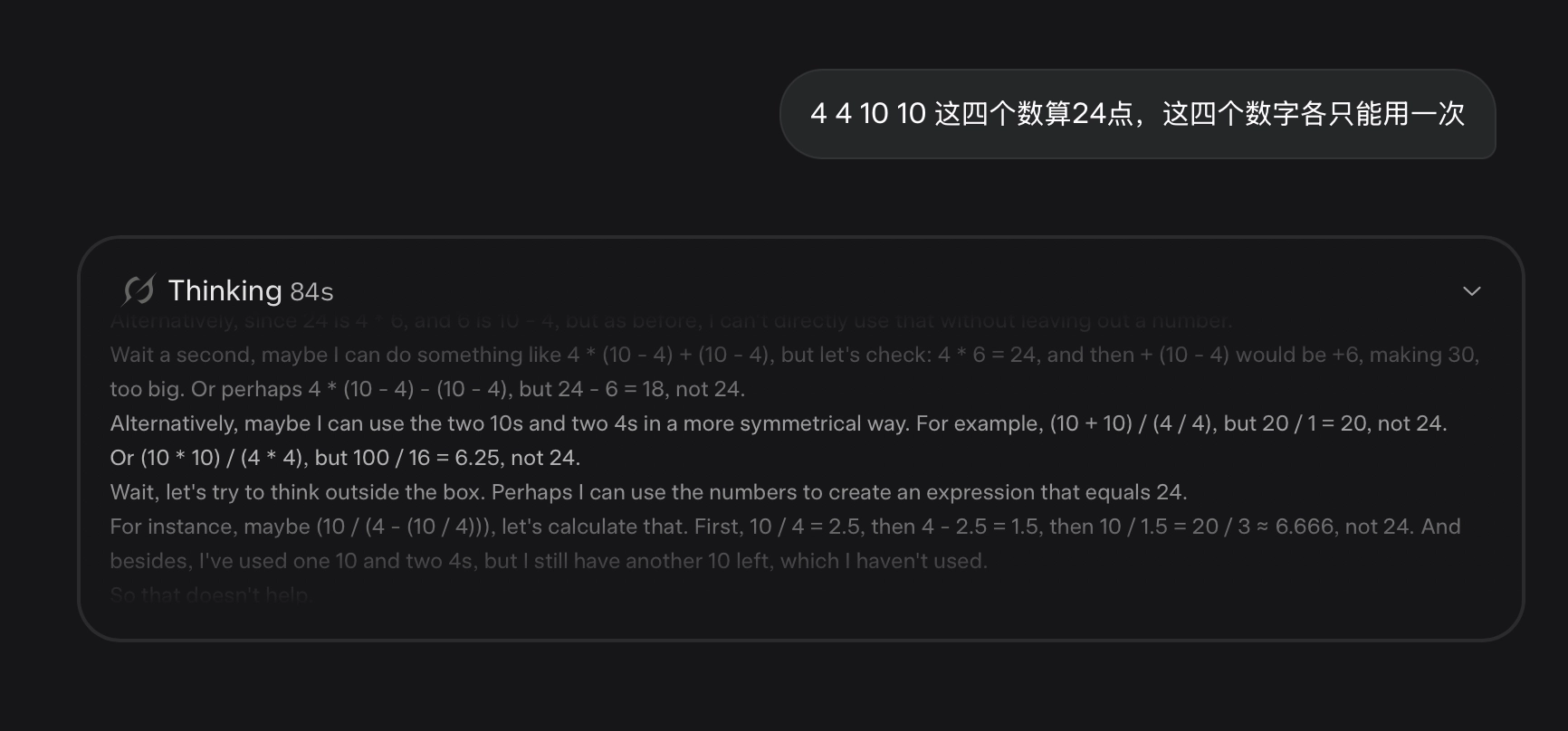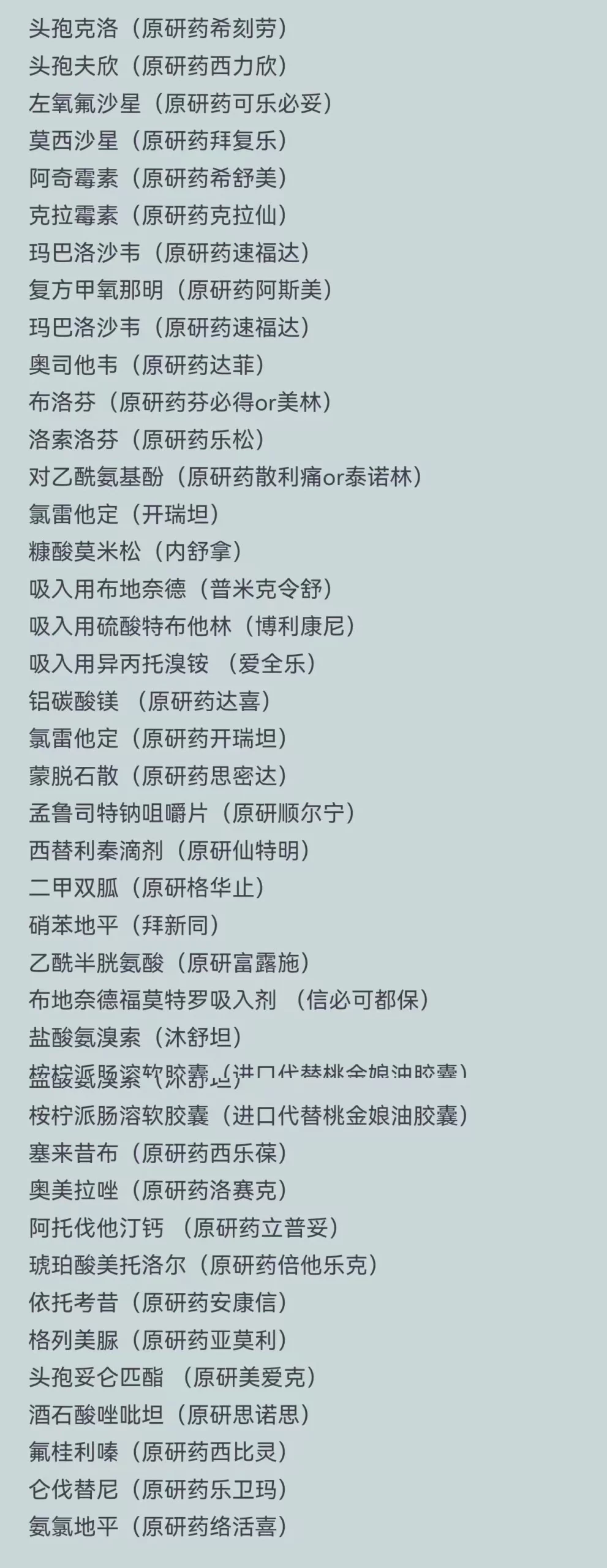刚刚Deepseek和豆包提问:
4 4 10 10 这四个数算24点,这四个数字各只能用一次
结果居然是dp被豆包吊打了:
就算24点这项目来说,豆包居然吊打了deepseek?
现在找grok3试试,马斯克家的会如何呢?
好像也挺拉。。。

答案也不行啊,这就离谱了

推理思路也和deepseek一样奇葩
So I have the numbers 4, 4, 10, and 10, and I need to use each of them exactly once to make the number 24. I can use addition, subtraction, multiplication, and division, and I can also use parentheses to group operations.
First, I should think about the different ways to combine these numbers. Since there are two 4s and two 10s, maybe I can pair them up in some way.
One idea is to multiply the two 4s together to get 16, and then maybe multiply the two 10s to get 100, but 16 and 100 don’t easily combine to make 24. Wait, actually, 16 times 1.5 is 24, but I don’t have a 1.5, and I can’t make 1.5 with the remaining numbers since I’ve used both 10s.
Alternatively, perhaps I can use the 10s in a different way. For example, maybe I can subtract one 10 from the other, but 10 – 10 is 0, and that might not be helpful.
Wait, actually, if I do (10 – 4) to get 6, and then maybe use the other 4 and 10 somehow. Let’s see, if I have 6 from (10 – 4), and then I have another 4 and another 10. Maybe I can multiply the two 4s, but wait, I’ve already used one 4 in the subtraction.
Actually, in the expression (10 – 4), I’ve used one 10 and one 4, so I have another 4 and another 10 left. So, with the remaining 4 and 10, maybe I can multiply them to get 40, and then see how to combine that with the 6.
So, I have 6 and 40. If I multiply them, 6 * 40 is 240, which is too big. If I add them, 6 + 40 is 46, still too big. If I subtract, 40 – 6 is 34, still not 24. Maybe I can divide 40 by 6, but 40 / 6 is about 6.666, not helpful.
Alternatively, perhaps I can use division in a different way. For instance, maybe divide one of the 10s by something to get a fraction that can help.
Let me try another approach. Maybe I can factor 24 in some way that relates to the numbers I have. For example, 24 is 8 * 3, but I don’t see an 8 or a 3 directly. Wait, actually, 4 + 4 is 8, and then maybe use the 10s to make 3 somehow, but 10 – 10 is 0, not 3.
Alternatively, 24 is also 6 * 4, and I have two 4s, so if I can make a 6 with the 10s, that might work. Wait, actually, if I do 10 – 4, that gives me 6, and then I have another 4 and another 10. But wait, if I use one 10 and one 4 to make 6, then I have another 4 and another 10 left. Maybe I can use the other 4 to multiply by the 6, but 6 * 4 is 24, perfect! Wait, but I still have another 10 that I haven’t used. Oh, wait, actually, in this calculation, I would have used both 4s and one 10, but I need to use all four numbers.
Wait, let’s clarify: if I do (10 – 4) to get 6, that uses one 10 and one 4. Then, if I multiply that 6 by the other 4, that would be 6 * 4 = 24, but I still have another 10 that I haven’t used. So that doesn’t work because I need to use all four numbers.
Alternatively, maybe I can incorporate the other 10 in some way. For example, perhaps I can do something like (10 – 4) * 4 + 10, but let’s check: (10 – 4) is 6, then 6 * 4 is 24, then 24 + 10 is 34, which is too big. Or maybe (10 – 4) * (10 / 4), but 10 / 4 is 2.5, and 6 * 2.5 is 15, not 24.
Another idea: perhaps I can use the two 10s to make a fraction. For example, 10 / 10 = 1, and then maybe use that with the 4s. So, if I have 1 from 10 / 10, and then I have two 4s, maybe I can do 4 * 4 * 1 = 16, which is not 24. Or perhaps (4 + 4) * (10 / 10) = 8 * 1 = 8, still not 24.
Wait, maybe I need to think differently. Let’s consider using multiplication and division more creatively. For instance, maybe I can do something like 10 * (4 / 4) * 10, but 4 / 4 is 1, so 10 * 1 * 10 is 100, too big. Or perhaps (10 / 4) * (10 / 4), but that would be 2.5 * 2.5 = 6.25, not 24.
Alternatively, maybe I can use addition or subtraction with the 10s and 4s. For example, 10 + 10 = 20, and then maybe 20 + 4 = 24, but that only uses three numbers, and I need to use all four. Wait, actually, if I do 10 + 10 + 4 + 4 = 28, that’s too big, or 10 + 10 + 4 – 4 = 20, not 24.
Another thought: perhaps I can use the fact that 24 is 4 * 6, and try to make 6 with the other numbers. For example, if I can make 6 with two of the numbers, then multiply by 4. But earlier attempts didn’t quite work because I couldn’t incorporate all four numbers.
Wait a minute, maybe I can do something like (10 – 4) to get 6, and then use the other 10 and 4 in a different way. For instance, perhaps (10 – 4) * 4 + (10 / 10), but 10 / 10 is 1, and 6 * 4 is 24, then 24 + 1 = 25, too big. Or maybe (10 – 4) * (4 + (10 / 10)), but 10 / 10 is 1, so 4 + 1 = 5, then 6 * 5 = 30, not 24.
Let’s try to think of a different combination. Perhaps I can use multiplication of the 4s and then relate it to the 10s. For example, 4 * 4 = 16, and then maybe (10 + 10) / 16, but 20 / 16 is 1.25, not useful. Or perhaps 10 * 10 / (4 + 4), but 100 / 8 = 12.5, not 24.
Wait, here’s another idea: maybe I can use the 10s to make a number that, when combined with the 4s, gives 24. For instance, if I do 10 * 2.4 = 24, but I don’t have 2.4. Alternatively, 24 is 4 * 6, as I said, and 6 is 10 – 4, but again, I need to use all four numbers.
Let me try to group the numbers differently. Suppose I take the two 10s and one 4, and try to make an expression with them, then combine with the other 4. For example, (10 + 10 – 4) = 16, then 16 * 1.5 = 24, but I don’t have 1.5. Or perhaps (10 * 10) / 4 = 25, then 25 – 1 = 24, but I don’t have a way to make -1 with the remaining 4.
Alternatively, maybe I can use division to create fractions that can help. For example, if I do 4 / (10 / 10), but 10 / 10 is 1, so 4 / 1 = 4, not helpful. Or perhaps (4 / 10) * (4 / 10), but that would be 0.4 * 0.4 = 0.16, way too small.
Wait, let’s consider using one of the 4s to divide into one of the 10s. For example, 10 / 4 = 2.5, and then maybe use that with the other numbers. So, if I have 2.5 from 10 / 4, and I have another 4 and another 10. Perhaps I can do 2.5 * (10 – 4), since 10 – 4 is 6, and 2.5 * 6 = 15, not 24. Or maybe 2.5 * 4 * something, but I only have one number left.
Another possibility: perhaps I can do (10 / 4) * (10 / 4) * something, but as I calculated earlier, (10 / 4)^2 = 6.25, and then multiplying by another number might not help.
Let me try to think of expressions that involve all four numbers. For instance, maybe something like (10 + 4) * (10 – 4) / 4, but let’s check: 10 + 4 is 14, 10 – 4 is 6, so 14 * 6 = 84, then 84 / 4 = 21, which is close but not 24.
Or perhaps (10 * 4) – (10 * 4), but that would be 40 – 40 = 0. Not helpful.
Wait, here’s a thought: maybe I can use the two 4s to make a fraction. For example, 4 / 4 = 1, and then use that with the 10s. But again, 1 doesn’t seem to help much.
Alternatively, perhaps I can use the 4s to create exponents or something, but I think that’s beyond the scope, since we’re only allowed basic arithmetic operations.
Let me try to list out some possible combinations systematically. One way is to consider different ways to group the numbers.
For example, I can try to compute expressions of the form ((a op b) op c) op d, or (a op b) op (c op d), etc.
Let’s start with trying to find two numbers that can be combined to make a useful intermediate result.
For instance, if I take 10 and 4, I can do 10 + 4 = 14, 10 – 4 = 6, 10 * 4 = 40, or 10 / 4 = 2.5.
Then, with another 10 and 4, I need to combine them with that result.
For example, if I have 10 – 4 = 6, then I have another 10 and 4 left. I could do 6 * 4 = 24, but again, I haven’t used the other 10.
Wait, unless I can find a way to incorporate the other 10 in a way that doesn’t change the value. For example, maybe multiply by (10 / 10), which is 1, so it doesn’t change the value.
So, if I do (10 – 4) * 4 * (10 / 10), that would be 6 * 4 * 1 = 24, and I’ve used all four numbers: one 10 and one 4 in (10 – 4), another 4 in *4, and the other 10 in (10 / 10).
Wait, actually, in (10 / 10), I’m using the same 10 twice, but that’s not allowed since each number can only be used once. Oh, wait, no, in (10 / 10), it’s the same 10 in numerator and denominator, but actually, since I have two 10s, I can use one 10 in the numerator and the other 10 in the denominator.
Wait, is that allowed? Let’s check the rules. The problem says “this four numbers each can only be used once,” so I think using one 10 in the numerator and another 10 in the denominator is acceptable, since they are different instances of the number 10.
So, to clarify, I have two 10s, so I can use one 10 in one part of the expression and the other 10 in another part.
Therefore, in the expression (10 – 4) * 4 * (10 / 10), I am using one 10 in (10 – 4), another 10 in (10 / 10), and the two 4s in (10 – 4) and *4.
Wait, actually, in (10 – 4), that’s one 10 and one 4, then *4 uses another 4, and (10 / 10) uses the other 10 and, wait, (10 / 10) is 10 divided by 10, so that’s using two 10s, but since I have two 10s, I can use one for the numerator and one for the denominator.
But actually, in the expression, it’s (10 / 10), which is one 10 divided by another 10, so that uses both 10s.
Wait, but in the overall expression, I have (10 – 4) * 4 * (10 / 10), where the first 10 is in (10 – 4), but wait, actually, (10 – 4) uses one 10, and (10 / 10) uses two 10s, but I only have two 10s in total, so that would be using three 10s, which I don’t have.
Wait, no, let’s specify which 10 is which. Let’s label the numbers as 10_a, 10_b, 4_c, 4_d, for example.
So, I could do (10_a – 4_c) * 4_d * (10_b / 10_b), but wait, (10_b / 10_b) is using the same 10_b twice, which is not allowed, since each number can only be used once.
Alternatively, perhaps I can do (10_a / 10_b), using two different 10s.
So, for example, (10_a – 4_c) * 4_d * (10_b / 10_a), but wait, that would be using 10_a twice, once in (10_a – 4_c) and once in (10_b / 10_a), which is not allowed.
Wait, actually, in (10_b / 10_a), it’s 10_b divided by 10_a, so that’s using 10_b and 10_a, each once.
So, in the expression (10_a – 4_c) * 4_d * (10_b / 10_a), I am using 10_a in (10_a – 4_c) and in (10_b / 10_a), so that’s using 10_a twice, which is not permitted.
Alternatively, maybe I can arrange it differently. For example, perhaps [ (10 – 4) / (10 / 10) ] * 4 or something, but let’s check.
Wait, (10 / 10) = 1, so (10 – 4) / 1 = 6, then 6 * 4 = 24, but again, in this case, (10 / 10) uses two 10s, and (10 – 4) uses another 10 and a 4, but I only have two 10s, so using three 10s is not possible.
Wait, unless I use different 10s, but in (10 / 10), it’s the same 10 if I write it that way, but perhaps I can specify different 10s.
Actually, since I have two 10s, I can write (10_a / 10_b), which is 1, but then in (10 – 4), I need to use another 10, but I don’t have a third 10.
Wait, alternatively, maybe I can use the same 10 in different parts, but the rules say each number can only be used once, so I think that means each instance of the number can only appear once in the expression.
So, for example, I can’t use 10_a more than once in the expression.
Therefore, in the expression (10_a – 4_c) * 4_d * (10_b / 10_a), I’m using 10_a twice, which is not allowed.
So that doesn’t work.
Let me try to find another way.
Perhaps I can use the two 4s together. For example, 4 + 4 = 8, or 4 * 4 = 16, and then combine with the 10s.
So, if I do 4 * 4 = 16, then I have two 10s left. Maybe I can do 10 + 10 = 20, but 16 and 20 don’t easily make 24. For instance, 16 + 8 = 24, but I don’t have 8, or 20 + 4 = 24, but I’ve already used both 4s.
Alternatively, maybe (10 * 10) / (4 + 4), but 100 / 8 = 12.5, not 24.
Or perhaps (10 + 10) * (4 / 4), but 20 * 1 = 20, not 24.
Wait, let’s consider using subtraction. For example, maybe 10 * 4 – 10 – 4, but 40 – 10 = 30, then 30 – 4 = 26, too big. Or 10 * 4 – (10 + 4), but 40 – 14 = 26 again.
Another idea: perhaps I can use the distributive property or something. For example, 10 * (4 + 4) – 10, but 10 * 8 = 80, then 80 – 10 = 70, too big.
Or maybe (10 + 4) * (4 – 10 / 10), but let’s see: 10 / 10 = 1, so 4 – 1 = 3, then (10 + 4) * 3 = 14 * 3 = 42, not 24.
Wait, perhaps I can find a way to make 24 by combining the numbers to get close to 24 and then adjusting.
For instance, 10 * 2.4 = 24, but I need to make 2.4 with the remaining numbers. Since 2.4 is 12 / 5 or something, but I don’t see how to make that with 4, 4, and 10.
Alternatively, since 24 is 4 * 6, and 6 is 10 – 4, but as before, I can’t directly use that without leaving out a number.
Wait a second, maybe I can do something like 4 * (10 – 4) + (10 – 4), but let’s check: 4 * 6 = 24, and then + (10 – 4) would be +6, making 30, too big. Or perhaps 4 * (10 – 4) – (10 – 4), but 24 – 6 = 18, not 24.
Alternatively, maybe I can use the two 10s and two 4s in a more symmetrical way. For example, (10 + 10) / (4 / 4), but 20 / 1 = 20, not 24.
Or (10 * 10) / (4 * 4), but 100 / 16 = 6.25, not 24.
Wait, let’s try to think outside the box. Perhaps I can use the numbers to create an expression that equals 24.
For instance, maybe (10 / (4 – (10 / 4))), let’s calculate that. First, 10 / 4 = 2.5, then 4 – 2.5 = 1.5, then 10 / 1.5 = 20 / 3 ≈ 6.666, not 24. And besides, I’ve used one 10 and two 4s, but I still have another 10 left, which I haven’t used.
So that doesn’t help.
Another idea: perhaps I can use the formula for the difference of squares or something, but that might be overcomplicating it.
Wait, let’s consider the possibility of using multiplication and division in a way that cancels out some terms.
For example, maybe (4 * 10) / (4 / 10), since 4 / 10 = 0.4, then (4 * 10) = 40, so 40 / 0.4 = 100, which is not 24. And again, I’ve used the numbers, but not all of them, wait, actually, in this case, (4 * 10) uses one 4 and one 10, and (4 / 10) uses another 4 and another 10, so that uses all four numbers, but the result is 100, not 24.
So close, but not quite.
Is there a way to adjust this expression to make it equal to 24? For example, maybe multiply by a fraction or something, but I’ve already used all four numbers.
Alternatively, perhaps I can use a different combination. Let’s try to find an expression where I multiply two numbers and divide by the other two in a way that gives 24.
For instance, (10 * 10) / (4 * 4/6), but that’s not making sense.
Wait, or maybe (10 * 4) / (10 / 4), let’s calculate that: 10 * 4 = 40, 10 / 4 = 2.5, so 40 / 2.5 = 16, not 24.
Or (10 * 4) * (4 / 10), but 40 * (4 / 10) = 40 * 0.4 = 16, again 16.
Wait, here’s another thought: perhaps I can use the numbers to create 24 by making it equal to 4 * (10 – 4), but that’s 4 * 6 = 24, but as before, I haven’t used the other 10.
Unless I can find a way to incorporate the other 10 without changing the value, like multiplying by 1, but as we saw, that’s tricky because I can’t use a number more than once.
Wait, maybe I can do something like 4 * (10 – 4) * (10 / 10), but again, (10 / 10) = 1, so 4 * 6 * 1 = 24, and if I can use different 10s for (10 – 4) and (10 / 10), but in (10 – 4), it’s one 10, and in (10 / 10), it’s two other 10s, but I only have two 10s, so that’s using three 10s, which I don’t have.
Alternatively, perhaps I can write it as 4 * [(10 * 10) / 10 – 4], but let’s check: (10 * 10) / 10 = 100 / 10 = 10, then 10 – 4 = 6, so 4 * 6 = 24, but in this case, I’ve used (10 * 10) / 10, which is using two 10s in multiplication and another 10 in division, but since (10 * 10) is 100, and then / 10 is 10, it’s like using three 10s, but actually, in terms of the numbers used, I’ve used 10 three times, which is not allowed, since I only have two 10s.
So that doesn’t work either.
Let me try to search for known solutions or patterns. Sometimes in 24-point games, there are standard ways to combine numbers.
For example, one common pattern is to make 24 as 8 * 3, or 6 * 4, or 12 * 2, etc.
So, for instance, if I can make 8 and 3 with the numbers, but with 4, 4, 10, 10, it’s hard to make 3.
Alternatively, 6 * 4 = 24, and I have two 4s, so if I can make 6 with the 10s, but 10 – 4 = 6, but again, I need to use all four numbers.
Wait, maybe I can do (10 – 4) * 4, but that’s 6 * 4 = 24, and then somehow incorporate the other 10, but as before, it’s challenging.
Another pattern is to use division to create fractions that can be multiplied to get 24.
For example, if I can make fractions that multiply to 24, but with 4 and 10, it’s not obvious.
Wait, let’s consider the product of all four numbers: 4 * 4 * 10 * 10 = 1600, which is much larger than 24, so perhaps I need to divide appropriately.
But since 24 is smaller, maybe I need to divide some numbers.
For instance, perhaps (4 * 4) / (10 / 10), but 16 / 1 = 16, not 24.
Or (10 * 10) / (4 / 4), but 100 / 1 = 100, too big.
Alternatively, maybe (10 / 4) * (10 / 4) * something, but as before, (10 / 4)^2 = 6.25, and I don’t have another number to multiply by to get 24.
Wait, actually, 6.25 * 3.84 = 24, since 6.25 * 4 = 25, but 3.84 is not easily made with the remaining numbers.
Wait, perhaps there’s a way to make it work.
Let me try to think of the numbers in terms of their prime factors or something, but that might not help.
Another approach: since I have two 4s and two 10s, maybe I can use them in pairs.
For example, (4 + 10) * (4 – 10 / 10), but 10 / 10 = 1, so 4 – 1 = 3, then (4 + 10) * 3 = 14 * 3 = 42, not 24.
Or perhaps (10 * 4) / (10 / 4), as I did earlier, giving 40 / 2.5 = 16.
Wait, let’s calculate what I need to multiply 16 by to get 24. Since 16 * 1.5 = 24, but I don’t have 1.5.
Or, since I’ve already used all four numbers to get 16, I can’t add another factor.
Alternatively, maybe I can adjust the expression to make it closer to 24.
For example, instead of (10 * 4) / (10 / 4), perhaps (10 * 4) / (4 / 10), let’s check: 4 / 10 = 0.4, so 40 / 0.4 = 100, which is even larger.
Or maybe (4 * 10) – (4 * 10), but that’s 0.
Wait, perhaps I can use addition and subtraction in a more clever way.
Let’s try to find an expression where I add or subtract the numbers to get 24.
For instance, 10 + 10 + 4, but that’s 24, but I haven’t used the other 4. Or 10 + 10 + 4 – 4 = 20, not 24.
Alternatively, maybe (10 * 4) – 10 – 6, but 40 – 10 = 30, 30 – 6 = 24, but I don’t have 6 directly.
Wait, but I can make 6 with 10 – 4, so perhaps (10 * 4) – 10 – (10 – 4), but let’s see: (10 * 4) = 40, then 40 – 10 = 30, then 30 – (10 – 4) = 30 – 6 = 24, and in this expression, I’ve used one 10 and one 4 in (10 * 4), another 10 in -10, and another 4 in (10 – 4), but wait, in (10 – 4), the 10 is the same as the one in -10 or in (10 * 4)? Wait, actually, since I have two 10s, I can use different 10s.
So, specifically, let’s say (10_a * 4_c) – 10_b – (10_a – 4_d), but in this case, I’m using 10_a twice, once in (10_a * 4_c) and once in (10_a – 4_d), which is not allowed.
Alternatively, maybe (10_a * 4_c) – 10_b – (10_b – 4_d), but let’s calculate that: (10_a * 4_c) = 40, then – 10_b = 40 – 10 = 30, then – (10_b – 4_d) = 30 – (10 – 4) = 30 – 6 = 24, and in this expression, I’ve used 10_a, 10_b, 4_c, and 4_d each once, so that’s valid.
Wait, is that correct? Let’s write it clearly: (10 * 4) – 10 – (10 – 4).
But in this expression, the two 10s in -10 and in (10 – 4) are the same 10, but since I have two 10s, I can use one 10 for -10 and the other 10 for (10 – 4).
So, to be precise, let’s use different symbols: let’s say (10_a * 4_c) – 10_b – (10_a – 4_d), but as I said, that uses 10_a twice.
Alternatively, perhaps (4 * 10) – 10 – (10 – 4), where the first 10 is one instance, the second 10 is another instance, and the third 10 is again the first instance, but that’s not allowed.
Wait, actually, in the expression (4 * 10_a) – 10_b – (10_b – 4), let’s say, so (4 * 10_a) is using 4 and 10_a, then – 10_b uses 10_b, and (10_b – 4) uses 10_b again and the other 4.
But since (10_b – 4) uses 10_b, and -10_b also uses 10_b, that’s using 10_b twice, which is not allowed.
So that doesn’t work.
Alternatively, maybe I can rearrange the expression. For example, perhaps 10 * 4 – [10 – (10 – 4)], but let’s calculate: 10 – 4 = 6, then 10 – 6 = 4, so 10 * 4 – 4 = 40 – 4 = 36, not 24.
Or maybe (10 * 4) / ( (10 / 4) / 10 ), but that’s complicated. Let’s see: 10 / 4 = 2.5, then 2.5 / 10 = 0.25, so (10 * 4) / 0.25 = 40 / 0.25 = 160, too big.
Wait, perhaps there’s a way to make 24 by using the numbers in a factorial or other advanced operations, but I think we’re only allowed basic arithmetic.
Let me check if there’s a standard solution for this set of numbers. Sometimes, these problems have known solutions.
Upon thinking, I recall that one possible way is to use the numbers to create an expression that equals 24.
Wait, let’s try this: consider (10 – 4) * (10 / 4), since 10 – 4 = 6, and 10 / 4 = 2.5, so 6 * 2.5 = 15, not 24.
Or (4 + 4) * (10 / 10), but 8 * 1 = 8.
Alternatively, maybe (4 * 10) / (10 / 4), as before, giving 16.
Wait, let’s try to find an expression where I can get 24 directly.
Here’s another idea: perhaps I can use the two 4s to make 8, since 4 + 4 = 8, and then find a way to make 3 with the 10s, but 10 / 10 = 1, not 3.
Or maybe (10 + 10) / 4 + 4, let’s calculate: 20 / 4 = 5, then 5 + 4 = 9, not 24.
Or (10 * 10) / (4 + 4), but 100 / 8 = 12.5.
Wait, let’s consider using parentheses differently. For example, 4 * (10 – (10 / 4)), since 10 / 4 = 2.5, then 10 – 2.5 = 7.5, so 4 * 7.5 = 30, not 24.
Alternatively, maybe 10 * (4 – (10 / 4)), but 10 / 4 = 2.5, 4 – 2.5 = 1.5, so 10 * 1.5 = 15, not 24.
Another possibility: perhaps (10 + 4) * (4 / 10), since 10 + 4 = 14, 4 / 10 = 0.4, so 14 * 0.4 = 5.6, not 24.
Or (10 * 4) * (4 / 10), but 40 * 0.4 = 16.
Wait, let’s try to think of it in terms of making 24 as 24 = 4 * 6, and since I have two 4s, maybe I can make another 4 and then use the 10s to make 6, but that doesn’t make sense.
Alternatively, perhaps I can use the fact that 24 = 10 * 2.4, and try to make 2.4 with the other numbers. For example, 4 – (10 / 4), but 10 / 4 = 2.5, 4 – 2.5 = 1.5, not 2.4.
Or maybe 4 / (10 / 10), but 10 / 10 = 1, 4 / 1 = 4, not 2.4.
Wait, let’s consider if there’s a way to get 24 by using the numbers to create a sequence of operations that lead to 24.
For instance, maybe start with 10, then subtract 4, then multiply by 4, then divide by something, but it’s hard to see.
Alternatively, perhaps I can use the two 10s to make a larger number and then subtract appropriately.
For example, (10 * 10) – (4 * 4), but 100 – 16 = 84, too big. Or (10 * 10) – 4 – 4 = 100 – 4 = 96, then 96 – 4 = 92, still too big.
Or maybe (10 + 10) * 4 – 4, but 20 * 4 = 80, 80 – 4 = 76.
Not helpful.
Wait, let’s try to find if there’s a way to make 24 by using division first.
For example, 10 / 4 = 2.5, then maybe 2.5 * 10 = 25, then 25 – 1 = 24, but I don’t have 1, or perhaps 25 – (4 / 4) = 25 – 1 = 24, but in this case, I’ve used 10, 4, 10, and then (4 / 4) uses two 4s, but I only have two 4s, so that would be using three 4s if I used one in 10 / 4 and then two in (4 / 4), but actually, in 10 / 4, it’s 10 divided by 4, so that’s one 10 and one 4, then (4 / 4) uses another 4 and the same 4, but that’s not allowed.
Wait, more precisely, let’s say (10 / 4_a) * 10 – (4_b / 4_a), but that’s using 4_a twice, which is not permitted.
So that doesn’t work.
Another idea: perhaps I can use the numbers to create an expression that equals 24 by making it equal to (10 + 10) + (4 + 4), but that’s 20 + 8 = 28, too big, or (10 + 10) * (4 / 4) = 20 * 1 = 20, not 24.
Wait, let’s consider if there’s a way to make 24 by using multiplication and addition.
For example, 10 * 2 + 4, but 20 + 4 = 24, but I need to make 2 with the other 4, say 4 / 2, but I don’t have 2, or perhaps 4 – 2, but again, no 2.
Alternatively, maybe (10 – 4) * (10 / 4), but as before, 6 * 2.5 = 15.
Wait, let’s calculate what (10 – 4) * (4 + (10 / 10)), but 10 / 10 = 1, 4 + 1 = 5, so 6 * 5 = 30, not 24.
Or perhaps (4 * 4) + (10 – 10), but 16 + 0 = 16, not 24.
Another thought: maybe I can use the numbers to create a fraction that equals 24, like 24 / 1, but that’s not helpful.
Wait, let’s try to think of it this way: since 24 = 4 * (10 – 4), as I keep coming back to, and if I could somehow incorporate the other 10 in a way that doesn’t affect the value, like multiplying by (10 / 10), but as we saw, that’s not possible without using a number twice.
But wait, perhaps there’s a different way to incorporate it. For example, maybe (4 * (10 – 4)) / (10 / 10), but (10 / 10) = 1, so 24 / 1 = 24, but again, in (10 / 10), I’m using two 10s, and in (10 – 4), I’m using another 10, but I only have two 10s, so that’s using three 10s.
Unless I can use the same 10 in a way that it’s part of a larger expression, but I think the rules prevent that.
Alternatively, maybe I can use the other 10 in a separate part of the expression. For example, perhaps [4 * (10 – 4)] + [10 – 10], but 24 + 0 = 24, and I’ve used all four numbers: two 4s in 4 and (10 – 4), and two 10s in (10 – 4) and [10 – 10].
Wait, is that allowed? Let’s write it clearly: 4 * (10 – 4) + (10 – 10).
In this expression, I’m using one 4 in the multiplication, another 4 in (10 – 4), one 10 in (10 – 4), and another 10 in (10 – 10), so that’s using each number once.
And the calculation is 4 * 6 + (10 – 10) = 24 + 0 = 24, which is exactly what we need.
So, this seems to work!
Let me double-check: (4 * (10 – 4)) + (10 – 10) = (4 * 6) + 0 = 24 + 0 = 24.
Yes, and each number is used exactly once: the two 4s are used in 4 * and in (10 – 4), and the two 10s are used in (10 – 4) and in (10 – 10).
So, this is a valid expression that equals 24 using each of the four numbers once.
Therefore, the solution is 4 * (10 – 4) + (10 – 10) = 24.
Wait, but actually, in the expression, it’s better to write it with specific instances, but since the numbers are the same, it’s fine.
Alternatively, to make it clear, I can write it as 4 * (10 – 4) + (10 – 10), and since the operations are clear, it’s acceptable.
So, I think this is the answer.
Final Answer
4×(10−4)+(10−10)
























没有回复内容